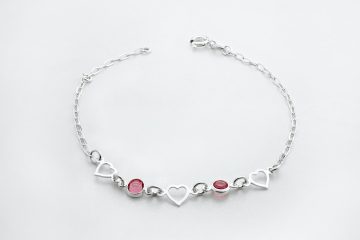Bracelet making is a highly rewarding and creative craft that allows you to express your personal style and create beautiful, unique accessories. Whether you are a beginner or an experienced jewelry maker, this step-by-step guide will help you master the art of bracelet making. From choosing the right materials to mastering various techniques, we will guide you through the process of creating stunning bracelets that you can proudly wear or gift to others.
Introduction to Bracelet Making
Bracelet making is a versatile craft that offers endless possibilities for creativity. It allows you to combine different materials, colors, and textures to create a wide range of designs. Before diving into the world of bracelet making, it’s important to familiarize yourself with the basic tools and materials you will need.
Tools and Materials for Bracelet Making
To get started with bracelet making, you will need a few essential tools and materials. Here’s a list of the basic supplies you should have on hand:
1. Beads: Choose from a wide variety of beads such as glass beads, gemstone beads, metal beads, or seed beads. Select beads that match your desired design and style.
2. Stringing Material: Options include elastic cord, beading wire, leather cord, or nylon thread. The choice of stringing material depends on the type of bracelet you want to create.
3. Findings: Findings refer to the components used to finish off your bracelet, such as clasps, jump rings, and crimp beads. These are essential for securing your bracelet.
4. Tools: Invest in a few basic tools like wire cutters, round-nose pliers, and crimping pliers. These tools will help you manipulate the materials and create professional-looking finishes.
5. Charms and Pendants: Optional embellishments that can add a personal touch to your bracelet. Choose charms and pendants that reflect your style or hold special meaning for you.
Now that you have gathered the necessary tools and materials, let’s move on to the step-by-step process of creating beautiful bracelets.
Step 1: Planning and Designing
Before you start making a bracelet, it’s essential to have a clear idea of the design you want to create. Take some time to sketch out your design or create a mood board to visualize the final result. Consider factors like color scheme, bead arrangement, and overall aesthetics. Planning ahead will ensure a smoother crafting process and a more cohesive end result.
Step 2: Stringing the Beads
Once you have your design in mind, it’s time to start stringing the beads. Depending on the type of bracelet you’re making, you may need to choose a suitable stringing material. For example, elastic cord works well for stretchy bracelets, while beading wire is more suitable for structured designs.
Begin by cutting a length of stringing material slightly longer than your desired bracelet length. Thread the beads onto the string in the desired pattern, making sure to leave enough excess string on both ends for finishing. Experiment with different bead combinations and arrangements to achieve the desired look.
Step 3: Adding Charms and Pendants
If you want to incorporate charms or pendants into your design, this is the time to do it. Attach them to your bracelet by using jump rings or wire loops. Carefully open the jump ring or loop using pliers, slide the charm onto the ring, and then close it securely. This step adds a personalized touch to your bracelet and allows you to express your individual style.
Step 4: Finishing Techniques
To ensure your bracelet is secure and long-lasting, it’s important to finish off the ends properly. The finishing technique you choose will depend on the type of stringing material you used. Here are a few common finishing techniques:
1. For elastic cord bracelets: Tie a secure knot, making sure to pull the cord tightly. Apply a small amount of jewelry glue to the knot for added security. Trim any excess cord.
2. For beading wire bracelets: Attach a clasp to each end of the wire using crimp beads. Thread a crimp bead onto the wire, pass it through the loop of the clasp, and then back through the crimp bead. Use crimping pliers to flatten the crimp bead, securing the clasp in place.
3. For leather cord bracelets: Tie a secure knot at each end of the cord, leaving a small loop. Attach a jump ring or toggle clasp to each loop using a strong knot.
Step 5: Experimenting with Different Techniques
Once you have mastered the basics of bracelet making, don’t be afraid to experiment with different techniques. There are countless ways to create unique and intricate designs. Here are a few techniques you can explore:
1. Bead Weaving: Learn how to create intricate patterns and designs using seed beads and specialized beading stitches like peyote stitch or right-angle weave.
2. Macramé: Explore the art of knotting cords to create intricate patterns and textures. Macramé bracelets can incorporate beads, charms, or even gemstones.
3. Wire Wrapping: Master the technique of wrapping wire around beads or gemstones to create stunning focal points for your bracelets.
4. Chainmaille: Dive into the world of chainmaille, an ancient technique that involves linking metal rings together to create intricate patterns and textures.
Conclusion
Bracelet making is a fulfilling craft that allows you to unleash your creativity and create beautiful accessories. By following this step-by-step guide, you can master the art of bracelet making and create stunning pieces that reflect your personal style. Remember to experiment with different materials, techniques, and designs to truly make each bracelet a unique masterpiece. So gather your tools, unleash your imagination, and start creating beautiful bracelets that will be cherished for years to come.
FAQs
Q1: Is bracelet making suitable for beginners?
A1: Absolutely! Bracelet making is a versatile craft that welcomes beginners. Start with simple designs and gradually explore more advanced techniques as you gain confidence.
Q2: Where can I find inspiration for bracelet designs?
A2: Inspiration can be found everywhere! Browse online platforms like Pinterest or Instagram for bracelet ideas, or draw inspiration from nature, fashion trends, or personal experiences.
Q3: What are some popular bead materials for bracelet making?
A3: Glass beads, gemstone beads, and seed beads are popular choices for bracelet making. Experiment with different materials to achieve the desired look and feel.
Q4: Can I sell the bracelets I make?
A4: Absolutely! Many people turn bracelet making into a profitable business by selling their creations online, at local craft fairs, or through social media platforms.
Q5: How can I personalize my bracelets?
A5: Adding charms, pendants, or personalized beads are great ways to add a personal touch to your bracelets. Consider incorporating birthstones, initials, or symbols that hold special meaning for you or the recipient.




